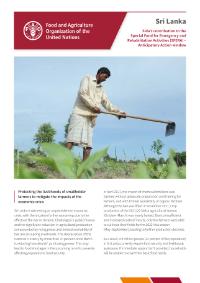Publications

Myanmar: Mitigating a potential food crisis in Rakhine State and Ayeyarwady Region through Anticipatory Action
08/2022
The political crisis in Myanmar started on 1 February 2021, and by May 2021, political tensions and conflict had led to more than 114 000 people moving across the country, with many returning to their rural townships and villages for safety.

Ukraine: Humanitarian response update, 21 July 2022
07/2022
This document provides an up-to-date summary of the humanitarian situation in Ukraine and the response of the Food and Agriculture Organization of the United Nations (FAO) on the ground.

Sri Lanka: Urgent call for assistance
07/2022
Sri Lanka is witnessing an unprecedented financial and economic crisis, and the situation is exacerbated by political and social turmoil.

FAO and Belgium provide emergency agricultural assistance to conflict-affected communities in Kayin and Kayah states
07/2022
Through the Special Fund for Emergency and Rehabilitation Activities (SFERA), the Government of the Kingdom of Belgium contributed USD 500 000 to FAO to mitigate the impact of the ongoing crisis in Myanmar on the most vulnerable households.

Colombia: 2022 Humanitarian Response Plan (HRP)
07/2022
Vulnerable households in Colombia remain affected by extreme weather events, armed violence, and the significant influx of refugees and migrants from the Bolivarian Republic of Venezuela.

Special Fund for Emergency and Rehabilitation Activities (SFERA): Annual Report 2021
07/2022
This annual report provides a brief description of the major operations initiated with the Special Fund for Emergency and Rehabilitation Activities (SFERA) for the 12-month period ending 31 December 2021. The report contains financial data for this period, as well as data since the Fund became operational.

Lebanon: DIEM – Data in Emergencies Monitoring brief, round 2
07/2022
This Data in Emergencies Monitoring (DIEM-Monitoring) brief shares the results of a second-round field assessment conducted between March and April 2022 in Lebanon.

Pakistan: DIEM – Data in Emergencies Monitoring brief, round 3
07/2022
This Data in Emergencies Monitoring (DIEM-Monitoring) brief shares the results of a third-round field assessment conducted between March and April 2022 in Pakistan.

Sri Lanka: Sida’s contribution to the Special Fund for Emergency and Rehabilitation Activities (SFERA) – Anticipatory Action window
07/2022
Sri Lanka is witnessing an unprecedented economic crisis. Challenges in public finance and the significant reduction in agricultural production compounded by rising prices and limited availability of fuel are disrupting livelihoods.

Myanmar: Shocks, agricultural livelihoods and food security (Monitoring report, June 2022)
06/2022
This report shares the results of a joint analysis by the Food and Agriculture Organization of the United Nations (FAO) and the World Food Programme (WFP) on the agrifood system in Myanmar based on an assessment conducted from August to September 2021.
.jpg?sfvrsn=9e66adbe_11)
Managing animal health emergencies with a One Health approach
06/2022
The concept of One Health is woven into the fabric of the Food and Agriculture Organization of the United Nations (FAO) Emergency Management Centre for Animal Health (EMC-AH).

Drought in the Horn of Africa: Revised rapid response and mitigation plan to avert a humanitarian catastrophe (January–December 2022)
06/2022
The Horn of Africa is facing the third severe La Niña‑induced drought episode in a decade, and the region is on the verge of a catastrophe if humanitarian assistance is not urgently scaled up and sustained.

The Niger: DIEM – Data in Emergencies Monitoring brief, round 3
06/2022
This Data in Emergencies Monitoring (DIEM-Monitoring) brief shares the results of a third-round field assessment conducted between February and March 2022 in the Niger.

Palestine: Humanitarian Response Plan 2022
06/2022
In 2021, about two out of five people were food insecure in Palestine.

Mauritanie: Contribution de la Belgique à travers le Fonds spécial pour les activités d’urgence et de relèvement (SFERA)
06/2022
La Mauritanie est particulièrement concernée par le changement climatique et le phénomène de désertification qui impactent considérablement les disponibilités en eau et en ressources fourragères.

The Niger: Response overview (June 2022)
06/2022
For over a decade, the Niger has experienced a food security crisis with agricultural and pastoral production deficits.

South Sudan: Humanitarian Response Plan 2022
06/2022
South Sudan is facing one of the worst food security and nutrition crises globally. Almost 63 percent of the population is likely to be in acute food insecurity, of whom 87 000 people facing extreme hunger with no or limited coping mechanisms.

Ukraine: Humanitarian response update, 13 June 2022
06/2022
FAO's revised Rapid Response Plan was issued on 19 April, seeking USD 115.4 million to assist 979 320 people in rural areas through December.

Hunger Hotspots: FAO-WFP early warnings on acute food insecurity: June to September 2022 Outlook
06/2022
The Food and Agriculture Organization of the United Nations (FAO) and the World Food Programme (WFP) warn that acute food insecurity is likely to deteriorate further in 20 countries or situations (including two regional clusters) – called hunger hotspots – during the outlook period from June to September 2022.

Tigray: Urgent call for assistance
06/2022
Tigray’s Meher season is just weeks away (June/July 2022). With the rainfall outlook favourable (normal to above-normal), the season offers a critical and cost-effective opportunity to improve food availability across the region
